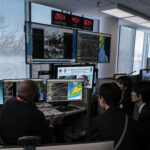Much of Japan’s Pacific coast could be inundated by a tsunami more than 34 meters (112 feet) high if a powerful earthquake hits offshore, according to revised estimates by a government panel.
The panel of experts says any tsunami unleashed by a magnitude-9.0 earthquake in the Nankai trough, which runs east of Japan’s main island of Honshu to the southern island of Kyushu, could top 34 meters at its highest.
An earlier forecast in 2003 put the potential maximum height of such a tsunami at less than 20 meters (66 feet).
Last March’s magnitude-9.0 earthquake spawned a 14-meter (45-foot) wave that devastated most of Japan’s northeastern coast and triggered meltdowns at a nuclear power plant.
The revised tsunami projections, contained in a report released Saturday and posted on a government website, are based on new research following last March’s magnitude-9.0 earthquake and tsunami, which devastated a long stretch of Japan’s northeastern coast and killed about 19,000 people.
Last year’s catastrophe and the ensuing crisis at the Fukushima Dai-ichi nuclear power plant, prompted sweeping reviews of Japan’s disaster preparedness and criticism over apparent failures to take into account potential risks.
The tsunami knocked out power at the 40-year-old coastal nuclear plant, leading to the worst nuclear disaster since Chernobyl in 1986. Tens of thousands of residents have had to leave the area, and it’s unclear whether some will ever be able to move back.
The Fukushima plant was designed to withstand a 6-meter (20-foot) tsunami, less than half the height of the surge that hit it on March 11, 2011.
The latest forecast shows a tsunami of up to 21 meters (69 feet) could strike near the Hamaoka nuclear plant. Its operator, Chubu Electric Power Co., is building an 18-meter (59-foot) high sea wall to counter tsunamis. The wall is due to be completed next year.
The plant was shut down in 2011 due to estimates it has a 90 percent chance of being hit by a magnitude 8.0 or higher quake within 30 years.
In other unsettling news, another government report shows that a strong earthquake hitting the Tokyo Bay region could shake the Tokyo-Yokohama metropolitan area – home to more than 33 million people – at the maximum seismic intensity of 7 on the Japanese scale.
The report, issued Friday by the Ministry of Education, came in the form of mapping that shows that much of the Tokyo region would likely experience severe shaking from a magnitude-7.3 earthquake inside Tokyo Bay.
The study prompted calls for Tokyo residents to be better prepared for such disasters. Although they live with the constant threat of a major earthquake that experts have long said is overdue for the region, not all living in the region keep recommended water and other supplies on hand.
A report in the newspaper Asahi Shimbun listed troubles that might be expected from a major quake, such as electricity outages that could persist for more than a week and water supply disruptions that could last for nearly a month, based on government estimates.
The revised tsunami forecast for a possible Nankai earthquake says Tokyo could expect waves up to 2.3 meters (7.6 feet) high. But at the coastal town of Kuroshio, on the island of Shikoku, the tsunami could top 34 meters (112 feet), it shows.
The computer modeling for the revised forecasts assumes a high tide for the highest estimates.
Was this article valuable?
Here are more articles you may enjoy.

 US Weather Service Merges Units as Staffing Pressure Rises
US Weather Service Merges Units as Staffing Pressure Rises  Novogratz’s Galaxy to Pay $200 Million in NY Luna Settlement
Novogratz’s Galaxy to Pay $200 Million in NY Luna Settlement  Scammers Are Pushing Auto Loan Fraud to Record Levels
Scammers Are Pushing Auto Loan Fraud to Record Levels  Auto Insurer Fined for Data Breach That Impacted 45K New Yorkers
Auto Insurer Fined for Data Breach That Impacted 45K New Yorkers 